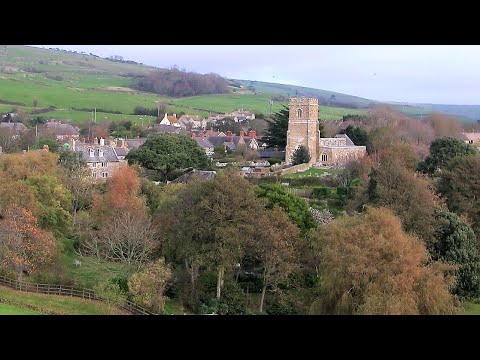Abbotsbury is a village and civil parish in the English county of Dorset. It is in the Dorset unitary authority area and is situated about 1 mile (1.6km) inland from the English Channel coast. In the 2011 census the civil parish had a population of 481.
The coastline within Abbotsbury parish includes a section of Chesil Beach, an 18-mile (29km) barrier beach which is part of the Jurassic Coast, a World Heritage Site.
Abbotsbury is known for its swannery, subtropical gardens and surviving abbey buildings, including St Catherine’s Chapel, a 14th-century pilgrimage chapel that stands on a hill between the village and the coast.
Much of Abbotsbury, including Chesil Beach, the swannery and subtropical gardens, is owned by the Ilchester Estate, which owns 61 square kilometres (15,000 acres) of land in Dorset.
The village of Abbotsbury comprises a long street of stone houses, many of which are thatched, with some dating from the 16th century. The street broadens at one point into an old market square. Parts of the street have a raised pavement. The village is surrounded by hills on all sides, except to the east; in 1905 Sir Frederick Treves described Abbotsbury as being “very pleasantly situated among the downs”. Dorset-born broadcaster and writer Ralph Wightman described the village as “possibly the most interesting in Dorset”.
The B3157 road between Abbotsbury and Burton Bradstock is notable for its fine coastal views.
One and a half miles (2.4 km) northwest of the village, at the top of Wears Hill, are the earthworks of Abbotsbury Castle, an Iron Age hill fort. The earthworks cover a roughly triangular area of about 10 acres (4.0 ha), of which about 4.5 acres (1.8 ha) are inside the ramparts.
In the 10th century a charter of King Edmund records a granting of land at Abbedesburi, a name which indicates the land may have once belonged to an abbot. In the 11th century King Cnut granted land at nearby Portesham to the Scandinavian thegn Orc (also Urki, Urk), who took up residence in the area with his wife Tola. The couple founded Abbotsbury Abbey and enriched it with a substantial amount of land.
In 1086, in the Domesday Book Abbotsbury was recorded as Abedesberie or Abodesberie; it had 62 households, 16 ploughlands, 32 acres (13 ha) of meadow and 2 mills. It was in the hundred of Uggescombe and the lords and tenants-in-chief were Abbotsbury Abbey and Hawise, wife of Hugh son of Grip.
Abbotsbury Abbey existed for 500 years, but was destroyed in the dissolution, although the abbey barn survived. Stone from the abbey was used in the construction of many buildings in the village, including the house of Abbotsbury’s new owner, Sir Giles Strangways.
The parish church’s Jacobean pulpit, showing damage from the Civil War skirmish (bullet hole on right)
In 1664, during the English Civil War, Roundheads (Parliamentarians) and Cavaliers (Royalists) clashed at Abbotsbury. Parliamentarians besieged the Royalists in the church of St. Nicholas; two bullet holes from the fight remain in the Jacobean pulpit. The Strangways house which had replaced the Abbey after the dissolution was also the scene of a skirmish, as the Royalist Colonel Strangways resisted the Parliamentarians, who besieged the house and burned it. The house gunpowder store exploded in the fire and the house was destroyed, together with the old abbey records which had been stored there.
In the late 17th, and early 18th centuries Abbotsbury experienced several fires, resulting in the destruction of virtually all its medieval buildings. Most of the historic secular buildings in the village today were built from stone in the 17th and 18th centuries.
County historian John Hutchins (1698–1773) recorded that fishing was the main industry in the village, and 18th-century militia ballot lists reveal that husbandry was also particularly important. Ropemaking, basketry and the manufacture of cotton stockings were other notable trades within the village, with records indicating hemp and withies being grown in the area.
In the early 19th century, Abbotsbury’s population grew steadily, from about 800 in 1801 to nearly 1,100 sixty years later.
Between 1885 and 1952, Abbotsbury was served by the Abbotsbury Railway, a 6 miles (9.7 km) branch from the main line to Weymouth. It was primarily designed for freight, in anticipation of the development of oil shale deposits and stone at Portesham, as well as iron ore at Abbotsbury which would be shipped to South Wales for processing. The Abbotsbury terminus of the line was inconveniently sited 1 mile (1.6 km) east of the village because the railway could not buy the land needed to build the station closer to the village.
Music:-
Daily Beetle by Kevin MacLeod is licensed under a Creative Commons Attribution 4.0 license. https://creativecommons.org/licenses/by/4.0/
Source: http://incompetech.com/music/royalty-free/index.html?isrc=USUAN1500025
Artist: http://incompetech.com/

